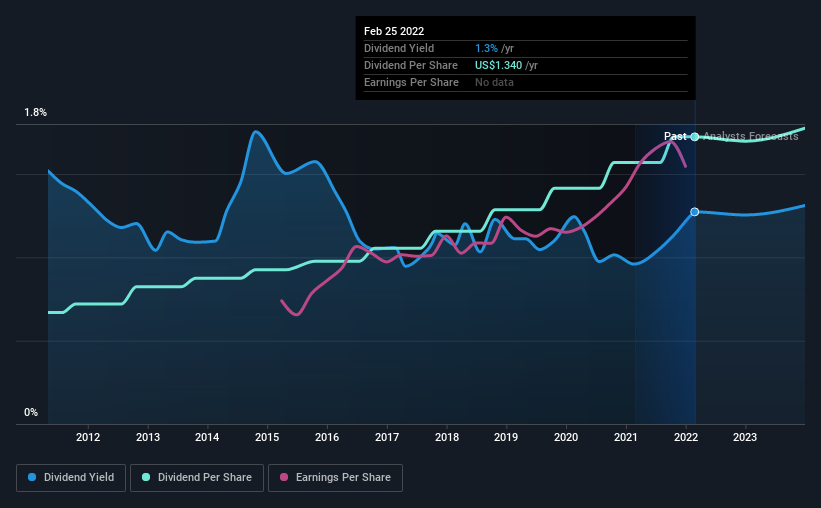Stepan Company (NYSE:SCL) Passed Our Checks, And It's About To Pay A US$0.34 Dividend
Stepan Company (NYSE:SCL) is about to trade ex-dividend in the next four days. The ex-dividend date is one business day before a company's record date, which is the date on which the company determines which shareholders are entitled to receive a dividend. The ex-dividend date is of consequence because whenever a stock is bought or sold, the trade takes at least two business day to settle. Accordingly, Stepan investors that purchase the stock on or after the 3rd of March will not receive the dividend, which will be paid on the 15th of March.
The company's next dividend payment will be US$0.34 per share, and in the last 12 months, the company paid a total of US$1.34 per share. Looking at the last 12 months of distributions, Stepan has a trailing yield of approximately 1.3% on its current stock price of $105.27. Dividends are a major contributor to investment returns for long term holders, but only if the dividend continues to be paid. So we need to investigate whether Stepan can afford its dividend, and if the dividend could grow.
View our latest analysis for Stepan
If a company pays out more in dividends than it earned, then the dividend might become unsustainable - hardly an ideal situation. Stepan is paying out just 21% of its profit after tax, which is comfortably low and leaves plenty of breathing room in the case of adverse events. Stepan paid a dividend despite reporting negative free cash flow over the last twelve months. This may be due to heavy investment in the business, but this is still suboptimal from a dividend sustainability perspective.
Click here to see the company's payout ratio, plus analyst estimates of its future dividends.
Have Earnings And Dividends Been Growing?
Stocks in companies that generate sustainable earnings growth often make the best dividend prospects, as it is easier to lift the dividend when earnings are rising. If business enters a downturn and the dividend is cut, the company could see its value fall precipitously. For this reason, we're glad to see Stepan's earnings per share have risen 10% per annum over the last five years.
Many investors will assess a company's dividend performance by evaluating how much the dividend payments have changed over time. In the past 10 years, Stepan has increased its dividend at approximately 9.9% a year on average. We're glad to see dividends rising alongside earnings over a number of years, which may be a sign the company intends to share the growth with shareholders.
The Bottom Line
Is Stepan worth buying for its dividend? Companies like Stepan that are growing rapidly and paying out a low fraction of earnings, are usually reinvesting heavily in their business. This strategy can add significant value to shareholders over the long term - as long as it's done without issuing too many new shares. In summary, Stepan appears to have some promise as a dividend stock, and we'd suggest taking a closer look at it.
So while Stepan looks good from a dividend perspective, it's always worthwhile being up to date with the risks involved in this stock. In terms of investment risks, we've identified 1 warning sign with Stepan and understanding them should be part of your investment process.
Generally, we wouldn't recommend just buying the first dividend stock you see. Here's a curated list of interesting stocks that are strong dividend payers.
Have feedback on this article? Concerned about the content? Get in touch with us directly. Alternatively, email editorial-team (at) simplywallst.com.
This article by Simply Wall St is general in nature. We provide commentary based on historical data and analyst forecasts only using an unbiased methodology and our articles are not intended to be financial advice. It does not constitute a recommendation to buy or sell any stock, and does not take account of your objectives, or your financial situation. We aim to bring you long-term focused analysis driven by fundamental data. Note that our analysis may not factor in the latest price-sensitive company announcements or qualitative material. Simply Wall St has no position in any stocks mentioned.

 Yahoo Movies
Yahoo Movies 

